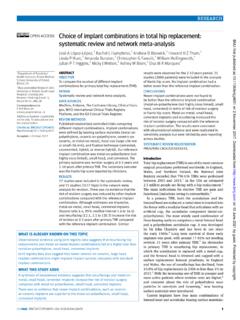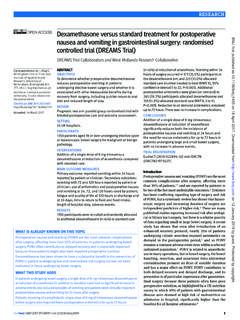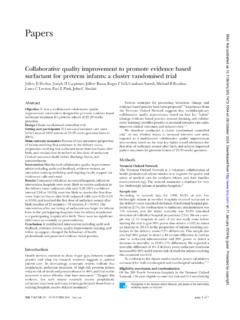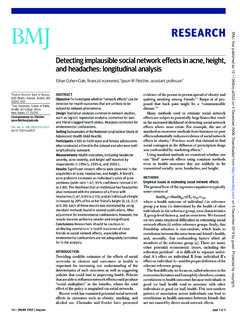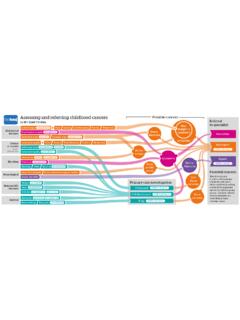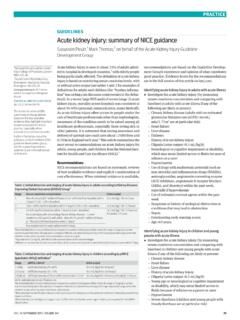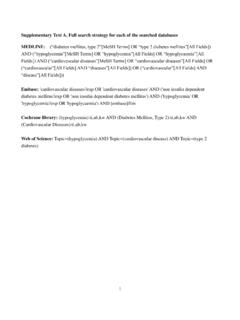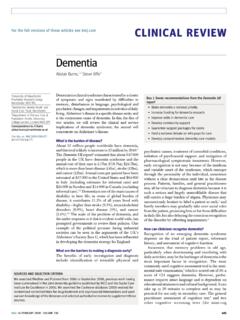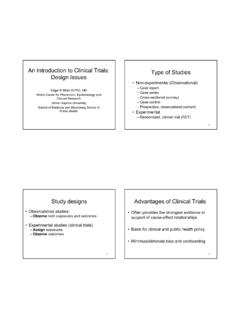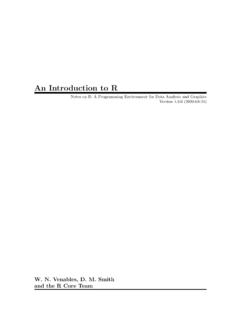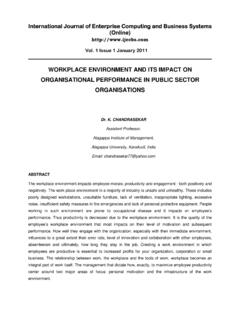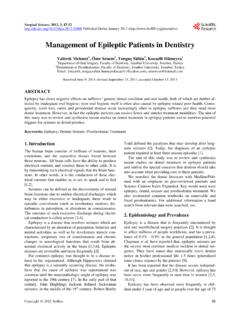Transcription of GP consultation rates for sequelae after acute covid-19 in ...
1 RESEARCHthe bmj | BMJ 2021;375:e065834 | doi: 1GP consultation rates for sequelae after acute covid-19 in patients managed in the community or hospital in the UK: population based studyHannah R Whittaker,1,2 Claudia Gulea,1,2 Ardita Koteci,1,2 Constantinos Kallis,1,2 Ann D Morgan,1,2 Chukwuma Iwundu,1,2 Mark Weeks,1,2 Rikisha Gupta,1,2 Jennifer K Quint1,2 ABSTRACTOBJECTIVESTo describe the rates for consulting a general practitioner (GP) for sequelae after acute covid-19 in patients admitted to hospital with covid-19 and those managed in the community, and to determine how the rates change over time for patients in the community and after vaccination for based general practices in England contributing to the Clinical Practice Research Datalink Aurum 002 patients with a diagnosis of covid-19 between 1 August 2020 and 14 February 2021 ( men.)
2 Median age 61 years), admitted to hospital within two weeks of diagnosis or managed in the community, and followed-up for a maximum of months. A negative control group included individuals without covid-19 (n=38 511) and patients with influenza before the pandemic (n=21 803).MAIN OUTCOME MEASURESC omparison of rates for consulting a GP for new symptoms, diseases, prescriptions, and healthcare use in individuals admitted to hospital and those managed in the community, separately, before and after covid-19 infection, using Cox regression and negative binomial regression for healthcare use. The analysis was repeated for the negative control and influenza cohorts. In individuals in the community, outcomes were also described over time after a diagnosis of covid-19 , and compared before and after vaccination for individuals who were symptomatic after covid-19 infection, using negative binomial to the negative control and influenza cohorts, patients in the community (n=437 943) had significantly higher GP consultation rates for multiple sequelae , and the most common were loss of smell or taste, or both (adjusted hazard ratio , 95% confidence interval to , P< ); venous thromboembolism ( , to , P< ); lung fibrosis ( , to , P= ), and muscle pain ( , to , P< ); and also for healthcare use after a diagnosis of covid-19 compared with 12 months before infection.
3 For absolute proportions, the most common outcomes 4 weeks after a covid-19 diagnosis in patients in the community were joint pain ( ), anxiety ( ), and prescriptions for non-steroidal anti-inflammatory drugs ( ). Patients admitted to hospital (n=18 059) also had significantly higher GP consultation rates for multiple sequelae , most commonly for venous thromboembolism ( , to , P< ), nausea ( , to , P< ), prescriptions for paracetamol ( , to , P< ), renal failure ( , to , P< ), and healthcare use after a covid-19 diagnosis compared with 12 months before infection. For absolute proportions, the most common outcomes 4 weeks after a covid-19 diagnosis in patients admitted to hospital were venous thromboembolism ( ), joint pain ( ), and breathlessness ( ).
4 In patients in the community, anxiety and depression, abdominal pain, diarrhoea, general pain, nausea, chest tightness, and tinnitus persisted throughout follow-up. GP consultation rates were reduced for all symptoms, prescriptions, and healthcare use, except for neuropathic pain, cognitive impairment, strong opiates, and paracetamol use in patients in the community after the first vaccination dose for covid-19 relative to before vaccination. GP consultation rates were also reduced for ischaemic heart disease, asthma, and gastro-oesophageal consultation rates for sequelae after acute covid-19 infection differed between patients with 1 National Heart and Lung Institute, Imperial College London, London, UK2 NIHR Imperial Biomedical Research Centre, London, UKCorrespondence to: J K Quint (or @RespEpi on Twitter; ORCID 0000-0003-0149-4869 Additional material is published online only.)
5 To view please visit the journal this as: BMJ 2021;375:e065834 bmj-2021-065834 Accepted: 23 November 2021 WHAT IS ALREADY KNOWN ON THIS TOPICP ersistent symptoms and new organ dysfunction after acute covid-19 infection have been recognised in several observational studies but these findings have been primarily seen in patients admitted to hospital with more severe diseaseFew studies have compared long term outcomes in individuals with covid-19 managed in the community, with most studies limited by small cohort sizes and selection biasesNo large population based cohort studies have assessed outcomes over time or after vaccination for covid-19 WHAT THIS STUDY ADDSG eneral practitioner consultation rates for sequelae after acute covid-19 infection differed between patients admitted to hospital with covid-19 and those managed in the communityPatients with covid-19 managed in the community had higher consultation rates for multiple sequelae , which were more prevalent than consultation rates after viral respiratory infections, such as influenza.
6 The most common sequelae were loss of smell or taste, or both, venous thromboembolism, lung fibrosis, and muscle pain, and also increased use of healthcare services compared with 12 months before infectionA small proportion ( ) of patients in the community had ongoing symptom related sequelae after acute covid-19 , with some reduction in symptom burden after vaccination on 22 June 2023 by guest. Protected by : first published as on 29 December 2021. Downloaded from RESEARCH2 doi: | BMJ 2021;375:e065834 | the bmjcovid-19 who were admitted to hospital and those managed in the community. For individuals in the community, rates of some sequelae decreased over time but those for others, such as anxiety and depression, persisted. rates of some outcomes decreased after vaccination in this covid-19 pandemic continues to challenge global public health, not least because of the growing realisation that the effects of covid-19 can affect individuals beyond the period of acute presentation.
7 Along with persistent symptoms, evidence is also emerging of new end organ dysfunction in those who recover from acute infection, with potentially negative effects on cardiovascular,1 respiratory,2 metabolic,3 haematological,4 psychological,5 and neurological working definitions of long covid have been established,7 8 understanding of the short and long term health consequences after covid-19 infection is limited. One of the main factors precluding a comprehensive understanding of the sequelae after acute covid-19 infection is the focus in the published literature and ongoing longitudinal studies on assessing outcomes in patients admitted to But about 80% of patients with covid-19 have mild disease, with only of patients in England requiring admission to hospital at the start of the first wave,10 and requiring admission to hospital in total since the start of the 35 Also, evidence is emerging of a considerable burden of sequelae after acute covid-19 infection in patients in the community (that is, patients not requiring admission to hospital).
8 12 13 Notably, patient group letters,14 surveys,15 and qualitative studies have highlighted a high proportion of patients with persistent debilitating Current estimates of the prevalence of long covid are highly variable but many are limited in their generalisability because of small cohort sizes and selection biases. Few studies, however, have compared outcomes across the range of severities of 18 Understanding the nature and burden of sequelae after acute covid-19 across different patient groups is crucial for effective rehabilitation services that can provide adequate and tailored support to those this study, we used a large UK primary care longitudinal dataset, broadly representative of the English population, to investigate new symptoms, diseases, prescriptions, and healthcare use, recorded in primary care, for two separate patient cohorts after acute covid-19 infection: patients admitted to hospital and patients managed in the community.
9 Also, we used two comparison cohorts to contextualise the findings: a negative control group of people without covid-19 , to understand healthcare use during the pandemic; and an historical cohort of patients with influenza before the pandemic, to understand whether associations in our covid-19 cohort were caused by acute respiratory infection or specifically by covid-19 . Focusing on the large population of patients with covid-19 in the community and taking advantage of the length of follow-up now available, we explored how this burden changed over time. Considering the emerging evidence of a possible improvement in symptoms after vaccination for covid-19 ,19 we also compared the prevalence of sequalae after covid-19 before and after vaccination in patients in the community who had sequelae after acute covid-19 sourceWe used the Clinical Practice Research Datalink (CPRD)
10 Aurum, a nationally representative database of anonymised primary care electronic healthcare records, which holds data on symptoms, diagnoses, prescriptions, test results, immunisations, consultations, admissions to hospital, and specialist referrals for more than 13 million patients in England, covering about 23% of the English As one of the largest longitudinal databases worldwide, its use has been extensively Clinical information is entered with SNOMED CT (systematised nomenclature of medicine-clinical terms) codes, and prescriptions are recorded with British National Formulary codes. Data from patient records are used only if they meet a certain standard of quality.


